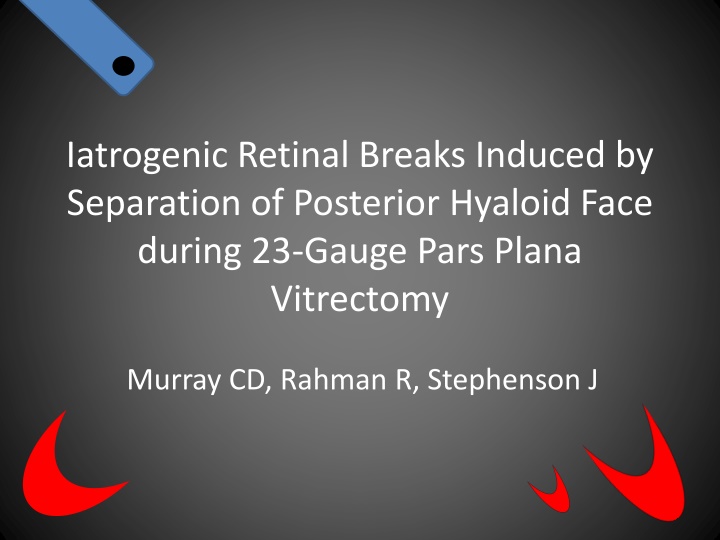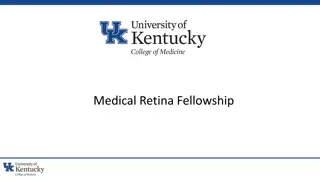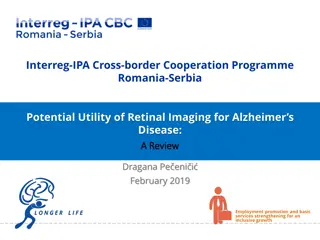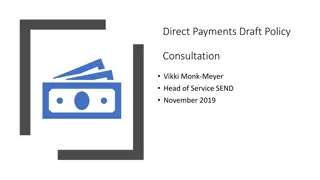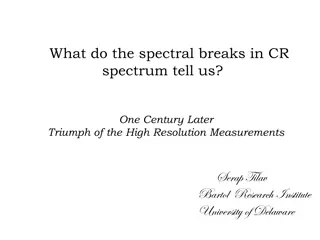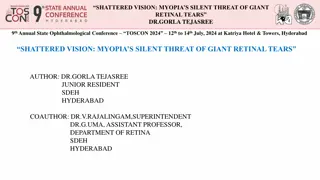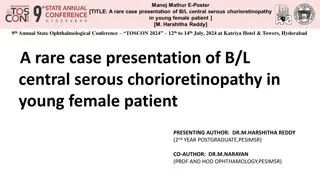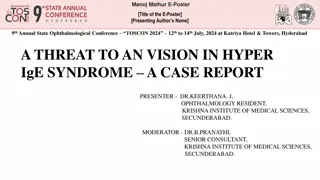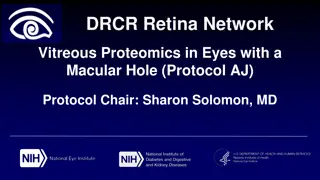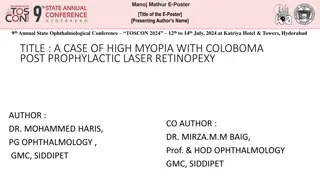Iatrogenic Retinal Breaks During Vitrectomy Study
This study explores iatrogenic retinal breaks resulting from the separation of the posterior hyaloid face during 23-Gauge Pars Plana Vitrectomy (PPV) surgery for various retinal conditions. It details the methods, findings, and outcomes of intraoperative retinal breaks, providing valuable insights for ophthalmic surgeons.
Download Presentation

Please find below an Image/Link to download the presentation.
The content on the website is provided AS IS for your information and personal use only. It may not be sold, licensed, or shared on other websites without obtaining consent from the author.If you encounter any issues during the download, it is possible that the publisher has removed the file from their server.
You are allowed to download the files provided on this website for personal or commercial use, subject to the condition that they are used lawfully. All files are the property of their respective owners.
The content on the website is provided AS IS for your information and personal use only. It may not be sold, licensed, or shared on other websites without obtaining consent from the author.
E N D
Presentation Transcript
Iatrogenic Retinal Breaks Induced by Separation of Posterior Hyaloid Face during 23-Gauge Pars Plana Vitrectomy Murray CD, Rahman R, Stephenson J
Purpose Describe incidence and features of intraoperative retinal breaks caused by iatrogenic separation of the posterior hyaloid face (PHF) during 23-G Pars Plana Vitrectomy (PPV) surgery for: Macula hole (MH) Vitreomacula traction (VMT) Epiretinal membrane (ERM) Floaters
Methods Prospective, consecutive, single surgeon, observational case series 23-Gauge TSV day case surgeries Calderdale Royal Hospital, UK 2009-2011 Approved by local ethics committee
Methods Collected baseline demographics, indication for surgery and axial length Pre-operative dilated fundoscopy Inclusion criteria: PPV for MH, VMT, ERM and floaters + Attached posterior hyaloid face (PHF)
Definitions Iatrogenic Posterior hyaloid face (PHF) separations: Suction induced or Adherent- requiring membrane blue with suction
Outcome measures Retinal break or tear versus No retinal break or tear Retinal haemorrhage - grouped with those categorised as not experiencing retinal break or tear Only U shaped tears included and pre-existing breaks excluded Pre-existing breaks = round or substantial surrounding pigment
Methods ALL Intra-operative findings recorded by surgeon immediately after surgery Forced entry and parsimonious multiple logistic regression analyses were conducted, using statistical software, to test for significance of association of the set of recorded factors and covariates with the dichotomised outcome measure.
Results n = 137 Age range: 32-94 years Mean age in years = 69.6 (SD 11.9) Mean axial length in mm = 23.7 (SD 1.41)
Results Pre operative diagnosis frequency (%) MH n = 71 (51.8) VMT n = 12 (8.8) ERM n = 27 (19.7) Floaters n = 27 (19.7)
Results Posterior hyaloid separations: 0.7 % 7.3 % Suction only n=126 Adherent n=10 92 % Missing n=1
Results 90.00% 80.00% 81.80% 70.00% 60.00% 50.00% 40.00% 30.00% 20.00% 18% 10.00% 0.00% No retinal break or tear n=112 Retinal break or tear n=25
Results Breakdown of pathologies for patients with iatrogenic retinal breaks or tears (n=25) MH n=13 (52%) VMT n=2 (8%) ERM n=3 (12%) Floaters n=7 (28%)
Results Forced entry and parsimonious multiple logistic regression models: Odds of retinal break or tear reduce by about 3-4% for each increasing year of age Forced entry: some substantive association with odds of retinal break or tear for adherent cases being around 3.7 times those for suction-only cases
Conclusions Mechanical detachment of PHF - important risk factor in formation of retinal breaks If undetected, the risk of Rhegmatogenous Retinal Detachment in post-operative period increases significantly This case series reports an 18.2% incidence of iatrogenic breaks associated with PHF separation during 23-G PPV
Conclusions Odds of retinal breaks reduce by 3-4% for each increasing year of age Adherent PHF cases are at 3.7 increased odds of iatrogenic breaks compared to suction-only cases Particular care intraoperatively in these cases to search for iatrogenic breaks
